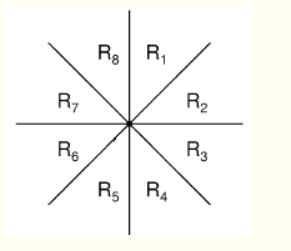2018 东北赛 Spin A Web (曼哈顿距离最小生成树)
7231: Spin A Web
时间限制: 1 Sec 内存限制: 128 MB
提交: 100 解决: 12
[提交] [状态] [讨论版] [命题人:admin]
题目描述
We have a canvas divided into grid with H rows and W columns. The square at the ith row from the top and the jth column from the left is represented as (i, j). (i, j) square has two value xi,j and yi,j .
Now we want to merge the squares to a connected web with minimal cost. Two squares can be connected if they are in the same row or column, and the cost of connecting (i0, j0) and (i1, j1) is
|xi0,j0 − xi1,j1 | + |yi0,j0 − yi1,j1 |.
输入
Input is given from Standard Input in the following format:
H W
x1,1 x1,2 . . . x1,W
.
.
xH,1 xH,2 . . . xH,W
y1,1 y1,2 . . . y1,W
.
.
yH,1 yH,2 . . . yH,W
Constraints
1 ≤ H × W ≤ 100000
−108 ≤ xi,j, yi,j ≤ 108(1 ≤ i ≤ H, 1 ≤ j ≤ W )
All of them are integers.
输出
Print one line denotes the minimal cost to merge the square to be a connected web.
样例输入
1 3
1 3 2
1 2 3
样例输出
5
来源/分类
2018东北四省赛
这道题的AC之路特别艰辛,我到最后都不知道我原来的程序为什么跑步过去。。。。
这是一个曼哈顿距离最小生成树的题,我们当时参加了省赛,最后一个简单的题没有水出来,与银牌擦肩而过
拿了三等奖。。。
这是与省赛第二天的东北赛的题目,如今又重现了。看到当时的榜单貌似只有一个人做了出来,然而这道题我也不太清楚坑点
在哪里。
曼哈顿最小距离生成树的学习博客:
https://www.cnblogs.com/xzxl/p/7237246.html
说一下我的理解:
对于平面上的n个点我们要求最小生成树是要预处理两两之间的曼哈顿距离,时间花费是n*n的,但是由于两点之间的花费是
曼哈顿距离,我们就有了优化的方法,这里其实是由很多无用边存在的。我们筛掉无用边之后最多只有4*n条边这个时候我们
求最小生成树的时间复杂度就变成了n*logn。
例如 假设当前点的位置在原点,在y轴向右旋转45度的范围内的点,只会有一个点与位于原点这个点相连。
具体的证明在上边的博客。
设i(x1,y1) j(x2,y2) 设i位于原点则,j在R1范围内的条件是 y2-x2>y1-x1(斜率大于1),并且x2>x1,
两点之间的曼哈顿距离为 |y2-y1|+|x2-x1| = y2+x2-(y1+x1) 由于y1+x1为定值,对于i点我们只需要求在
R1范围内 x>x1 并且 y-x> y1-x1 并且x+y最小的点。
如何实现:
1.对于x>x1 我们只需要按照x的值排序就能解决
2.如何保证 x+y最小, 对于每一个要查询的点 我们都查询位于他的横坐标之后的(y-x>要查询的)x+y最小的点
这一个可以用树状数组解决(树状数组维护一个(1-n)或者(i-n)的最大值,本题是维护了i到n的最大值)。
3.如何保证查询到的点的y-x>当前的y1-x1, 我们按照y-x的值排序,对于每一个a[i]的值(见下方代码)
pos之后的y-x肯定要比当前的y-x大,(位置可用二分来确定),又因为我们是倒叙遍历a[i]的,所以先插进去的点
都是在当前点后边的点,然后当前点pos的值我们更新为x+y并且记录id。
4.处理完R1区间还有R2 R3 ....,其实这些区间我们可以用区间变换把左边转移到R1区间,然后用处理R1区间的方法处理这些区间
,由于边是双向边,所以我们只需要处理位于原点(每个查询点都可以看作原点)右边的点。
具体的坐标变换过程如下:
对于第二步和第四步,我们按y=x翻转,即交换横纵坐标,第三部关于y轴对称一下。就将其他三个区间里的点都转换到R1范围内了。
对于本题有个限制就是只能合并同一行或者同一列,所以我们对每一行和每一列做一次曼哈顿距离就行。
#include
#include
#include
#include
#include
using namespace std;
#define LL long long
#define inf 2000000000
#define N 100015
#define lowb(x) (x&-x)
inline int read()
{
char c;
int sum=0;
int f=1;
c=getchar();
while(c<'0'||c>'9')
{
if(c=='-')f=-1;
c=getchar();
}
while(c>='0'&&c<='9')
{
sum=sum*10+c-'0';
c=getchar();
}
return sum*f;
}
int aa[N],cc[N];
void add(int p,int val,int id)
{
while(p>0)
{
if(aa[p]>val)
{
aa[p]=val;
cc[p]=id;
}
p-=lowb(p);
}
}
int query(int p,int n)
{
int m=inf;
int ans=-1;
while(p<=n)
{
if(aa[p]=0; i--)
{
int pos=lower_bound(b,b+kk,a[i])-b+1;
int ans=query(pos,n);
if(ans!=-1)
{
edg[tot].u=p1[p[i]].id;
edg[tot].v=p1[p[ans]].id;
edg[tot].k=abs(p1[p[i]].x-p1[p[ans]].x)+abs(p1[p[i]].y-p1[p[ans]].y);
tot++;
}
add(pos,p1[p[i]].x+p1[p[i]].y,i);
}
}
void Flip(int n)
{
for(int i=0; i<4; i++)
{
for(int j=0; j 附上原来一直超时的代码
#include
#include
#include
#include
#include
using namespace std;
#define LL long long
#define inf 2000000000
#define N 100015
#define lowb(x) (x&-x)
inline int read()
{
char c;
int sum=0;
int f=1;
c=getchar();
while(c<'0'||c>'9')
{
if(c=='-')f=-1;
c=getchar();
}
while(c>='0'&&c<='9')
{
sum=sum*10+c-'0';
c=getchar();
}
return sum*f;
}
struct BIT
{
int a[N],c[N];
void init(){
for(int i=1;i<=N;i++)a[i]=inf,c[i]=-1;
}
void add(int p,int val,int id)
{
while(p>0)
{
if(a[p]>val)
{
a[p]=val;
c[p]=id;
}
p-=lowb(p);
}
}
int query(int p,int n)
{
int m=inf;
int ans=-1;
while(p<=n)
{
if(a[p]=0;i--)
{
int pos=lower_bound(b,b+kk,a[i])-b+1;
int ans=T.query(pos,n);
if(ans!=-1)
{
edg[tot].u=p1[p[i]].id;
edg[tot].v=p1[p[ans]].id;
edg[tot].k=abs(p1[p[i]].x-p1[p[ans]].x)+abs(p1[p[i]].y-p1[p[ans]].y);
tot++;
}
T.add(pos,p1[p[i]].x+p1[p[i]].y,i);
}
}
void Flip(int n)
{
for(int i=0;i<4;i++)
{
for(int j=0;j 终于知道哪里出错了,我再也不把函数写在一个结构体里装X了。。。。
优化之后200多ms跑过。。
#include
#include
#include
#include
#include
using namespace std;
#define LL long long
#define inf 2000000000
#define N 100015
#define lowb(x) (x&-x)
int aa[N],cc[N];
void add(int p,int val,int id)
{
while(p>0)
{
if(aa[p]>val)
{
aa[p]=val;
cc[p]=id;
}
p-=lowb(p);
}
}
int query(int p,int n)
{
int m=inf;
int ans=-1;
while(p<=n)
{
if(aa[p]=1; i--)
{
int pos=AA[p[i].id];
int ans=query(pos,n);
if(ans!=-1)
{
edg[tot].u=p[i].id;
edg[tot].v=p[ans].id;
edg[tot].k=abs(p[i].x-p[ans].x)+abs(p[i].y-p[ans].y);
tot++;
}
add(pos,p[i].x+p[i].y,i);
}
}
void Flip(int n)
{
for(int i=0; i<4; i++)
{
for(int j=1; j<=n; j++)
{
if(i==1||i==3)
{
swap(p[j].x,p[j].y);
}
else if(i==2)
{
p[j].x=-p[j].x;
}
}
creat(n);
}
}
int f[N];
int Find(int x)
{
return f[x]==x?x:f[x]=Find(f[x]);
}
int w;
int getid(int i,int j)
{
return i*w+j;
}
int main()
{
//freopen("ce.txt","r",stdin);
int h;
scanf("%d%d",&h,&w);
int _id=1;
for(int i=0; i

